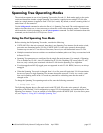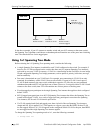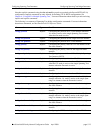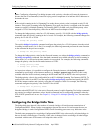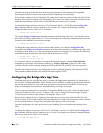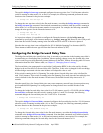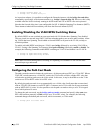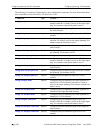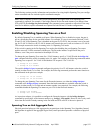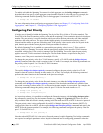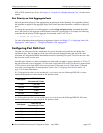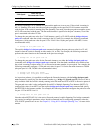
Configuring Spanning Tree Parameters Configuring Spanning Tree Bridge Parameters
OmniSwitch 6600 Family Network Configuration Guide April 2006 page 5-17
The explicit bridge 1x1 max age command configures the max age time for a VLAN instance when the
switch is running in either mode (1x1 or flat). For example, the following command performs the same
function as the command in the previous example:
-> bridge 1x1 455 max age 10
To change the max age time value for the flat mode instance, use either the bridge max age command or
the bridge cist max age command. Note that both commands are available when the switch is running in
either mode (1x1 or flat) and an instance number is not required. For example, the following commands
change the max age time for the flat mode instance to 10:
-> bridge max age 10
-> bridge cist max age 10
As in previous releases, it is possible to configure the flat mode instance with the bridge max age
command by specifying 1 as the instance number (e.g., bridge 1 max age 30). However, this is only avail-
able when the switch is already running in the flat mode and STP or RSTP is the active protocol.
Note that the max age time is not configurable for 802.1s Multiple Spanning Tree Instances (MSTI).
These instances inherit the max age time from the flat mode instance (CIST).
Configuring the Bridge Forward Delay Time
The bridge forward delay time specifies how long, in seconds, a port remains in the learning state while it
is transitioning to a forwarding state. In addition, when a topology change occurs, the forward delay time
value is used to age out all dynamically learned addresses in the MAC address forwarding table. For more
information about the MAC address table, see Chapter 2, “Managing Source Learning.”
The forward delay time propagated in a root bridge Configuration BPDU is the value used by all other
bridges in the tree for their own forward delay time. Therefore, if this value is changed for the root bridge,
all other bridges associated with the same instance will adopt this value as well.
If the switch is running in the 1x1 Spanning Tree mode, then a forward delay time value is defined for
each VLAN instance. If the switch is running in the flat Spanning Tree mode, then the forward delay time
value is defined for the flat mode instance. In both cases, the default forward delay time used is 15
seconds.
Note that specifying a low forward delay time may cause temporary network loops, because packets may
get forwarded before Spanning Tree configuration or change notices have reached all nodes in the
network.
To change the bridge forward delay time value for a VLAN instance, specify a VLAN ID with the bridge
forward delay command when the switch is running in the 1x1 mode. For example, the following
command changes the forward delay time for VLAN 455 to 10 seconds:
> bridge 455 forward delay 20
The explicit bridge 1x1 forward delay command configures the forward delay time for a VLAN instance
when the switch is running in either mode (1x1 or flat). For example, the following command performs
the same function as the command in the previous example:
-> bridge 1x1 455 forward delay 20
To change the forward delay time value for the flat mode instance, use either the bridge forward delay
command or the bridge cist forward delay command. Note that both commands are available when the
switch is running in either mode (1x1 or flat) and an instance number is not required. For example, the
following commands change the forward delay time for the flat mode instance to 10:



